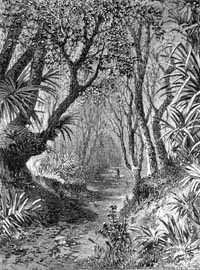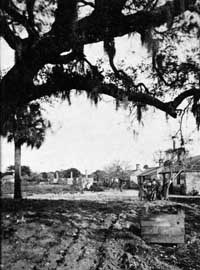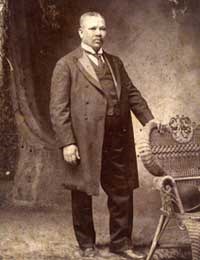
Image courtesy of the State Archives of Florida, Florida Memory At Kingsley Plantation the Union expedition found five thousand pounds of cotton stored on the grounds. During 1862 the blockading fleet adhered to a policy of "taking any public property that may be of military importance to the rebels, but respecting to the utmost private property" to not upset the relatively large contingent of Unionist whites in the Jacksonville area. However by July 1862, a confiscation act passed by Congress provided for the seizure of property belonging to any person who supported the rebellion. The commander of the Southern Blockade Fleet, Rear Admiral Samuel Dupont, viewed this act as "one of those irritating measures which do harm and no good" and indicating that men under his command would not practice "wholesale robberies". Regardless of whether actual practice in the field followed either Dupont's or Congress' directives, cotton was viewed as a source of wealth contributing to the Confederate war effort and therefore was not protected as private property. The expedition recorded that "we did all we could to get [the cotton] away, but after three days of hard work, carrying it nearly ten miles through mud and water, we only succeeded in bringing off some three thousand pounds." The presence of the cotton suggests that Charles Barnwell, Zephaniah Kingsley's grandnephew and owner of the plantation, had slaves on the property during 1861 for the spring planting and fall harvesting. The arrival of the blockading fleet to the St. Johns in the early months of 1862 had most certainly prevented this crop from being shipped.
The Union report did not mention slaves or any Barnwell family members being present at the plantation. By December 27, 1862, the Union Navy had been posting information along the St. Johns for two months regarding Lincoln's Emancipation Proclamation freeing slaves in Confederate States. Furthermore, the Proclamation was just days from taking effect on January 1st 1863. The Union blockading fleet commonly recorded the taking of slaves or arrival of runaways to contraband colonies because it then became the Navy's responsibility to protect and care for these individuals. It is likely that there were no slaves or Barnwell family at the plantation when the Union expedition arrived. Floridians along the St. Johns generally fled coastal areas with their slaves for the interior of the state to discourage runaways or prevent Union confiscation of their slaves. If similar fears had not yet caused Charles Barnwell to remove his slaves following the arrival of the blockade fleet off Fort George Island in March 1862, the establishment of a Union contraband colony mere miles away on Batton Island during the summer of 1862 surely did.

Image courtesy of the State Archives of Florida, Florida Memory Just months after the Fort George Island expedition, the Union fleet on the St. Johns participated in a joint mission with the Army to raid plantations along the river in early 1863. A Union soldier's memoir from the operation reflected the inconsistencies between actions and official policy when his unit was placed on duty safeguarding private property during the occupation of Jacksonville. This did not sit well with the Union soldiers who privately remarked "if they set us to guarding Rebel property again and [we] got a chance [we] would burn it up." True to their word, the Union soldiers set portions of Jacksonville on fire as they withdrew but another more telling chance to act against private property came days later at Mayport. When these same Union soldiers spotted a large plantation, they set off without orders on an unofficial raid, but found the plantation already sacked with "nothing worth going for." Additionally, not all Union officers operating on the St. Johns shared Dupont's objections with confiscating private property. Memoirs of the 1863 joint operation record Colonel James Montgomery willingly removing large quantities of household goods and furniture from plantations. Southern accounts of this operation describe it as "a general thieving expedition" and Montgomery as a "beast" who sought to displace Southerners from their homes.
Charles Barnwell entered into Confederate service in December 1863 as a member of the 5th Battalion Florida Cavalry. This virtually assures that the family had, by this point in the war, abandoned Kingsley Plantation. The membership of the 5th Battalion was largely drawn from the interior counties of North Florida and the Panhandle indicating that the Barnwell family lived away from the St. Johns at this time. Charles returned to Kingsley in November of 1865, six months after his unit's surrender at Tallahassee, and began selling off the property in parcels further signalling that he already had a residence elsewhere.

Image courtesy of Special Collections, Thomas G. Carpenter Library, Shortly after the arrival of the Union fleet on the St. Johns in early 1862, local residents began complaining of runaway slaves making their way to the protection of the gunboats. Prior to the 1863 Emancipation Proclamation freeing North Florida slaves, the Union Navy encouraged its officers to retain fugitive slaves but did not prevent the slaves' return to owners who could make a valid claim of supporting the Union. Regional Union commander Admiral Dupont further strengthened the local policy granting contraband some measure of freedom from bondage by the summer of 1862 through instructing the ships to "surrender none, no matter whether the parties asking for them professed to be loyal or not." This necessitated the removal of contraband to larger Union bases, such as Port Royal, South Carolina, that possessed the necessary infrastructure to provide for a reported two thousand contraband making their way to the river by October 1862. However, this was not always feasible, leading to the establishment of local contraband colonies at points that could easily be watched by the guns of the blockade fleet, such as Batton Island.
If Charles Barnwell had not removed his slaves from Kingsley Plantation following the arrival of the Union fleet, it is likely that at least a few of his slaves were encouraged to flee by the close Union proximity and possibility of freedom. Unfortunately, Union reports regarding contraband often only recorded numbers, not names, and did not always include the circumstances by which contraband came to them. Furthermore, Barnwell's slave records during this period are scant. However, military enlistment records may point to possible contraband from Fort George Island. In August 1862 the Secretary of War ordered the creation of the first official black regiment in the Union Army to be recruited mainly from contraband in the Port Royal area as well as enlistees acquired in the field. More than one thousand of the four-and-a-half thousand men in this and subsequent South Carolina contraband regiments had formerly been slaves or free blacks in North Florida. This number is all the more impressive considering the 1860 census had the total number of slaves in North Florida, of both sexes and all ages, at slightly less than twelve thousand. The enlistment records these and other contraband regiments who spent time in Florida are full of Kingsley surnames, however the large number of Barnwells is likely due to Charles Barnwell's wealthy plantation owning family hailing from the occupied Port Royal area. Yet, the opportunity, statistical probability, and circumstantial evidence certainly exists for slaves taking flight from the plantation during the first half of 1862.
A more concrete connection to the Kingsley family within the 1st South Carolina contraband regiment was Albert Sammis. Born a free black in the Arlington section of Duval County, Albert was the mixed race illegitimate child of John Sammis, the son-in-law of Zephaniah and Anna Kingsley. Despite his extramarital status, Albert was accepted into the family and raised alongside his half siblings in a household that interacted with Kingsley Plantation in the years before the war. Pension records indicate that at least seventeen fellow blacks in the South Carolina regiments knew Albert prior to his service.
|
Last updated: July 17, 2020
